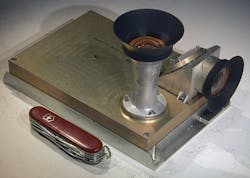Navy chooses radiation-hardened cameras from Malin Space Science for geosynchronous satellites
Officials of the Naval Research Laboratory (NRL) in Washington announced an $11 million contract to Malin Space Science last week for the Space Qualified Visible Cameras for Geosynchronous Operations project.
Malin experts will develop visible-light cameras with modified housings to meet the radiation environment of geosynchronous altitude, which is 22,000 miles above the Earth's surface, where solar winds and space radiation produce an extremely harsh environment for electro-optics and electronics.
The Space Qualified Visible Cameras project calls for Malin Space Science to design four different cameras for the Naval Research lab.
Related: Navy to approach industry for space-based CCD cameras for Earth observation satellite
Geosynchronous orbit holds a stationary orbit above the Earth to enable imaging systems on satellites to view the same areas of the Earth continuously; the Earth appears not to orbit underneath geosynchronous satellites.
On this contract, Malin Space Science Systems experts will increase the thickness and material of the camera housing case, while leaving the interior components of the camera unchanged, Navy officials say.
Malin Space Science designs and builds a variety of space-based imaging systems for satellite in-flight engineering diagnostics, deployment and actuator monitoring, space situational awareness, science observations, and public outreach.
The company designed the Camera Monitoring Assembly (CMA), which originally was for a NASA science mission, but later went into space on a classified Earth orbiter mission to image near-field objects from the spacecraft, company officials say.
The Malin CMS includes two 3-megapixel CMOS color imagers, each with its own narrow- and wide-field-of-view optics. The wide angle optics use a fold mirror to obtain a field of view orthogonal to that of the narrow field lens.
The CMA processes and JPEG-compresses images in real-time and buffers them to the on-board Flash memory buffer for later readout to the spacecraft.
On this contract Malin will do the work in San Diego and should be finished by May 2019. For more information contact Malin Space Science Systems online at www.msss.com, or the Naval Research Laboratory at www.nrl.navy.mil.
Learn more: search the Aerospace & Defense Buyer's Guide for companies, new products, press releases, and videos
